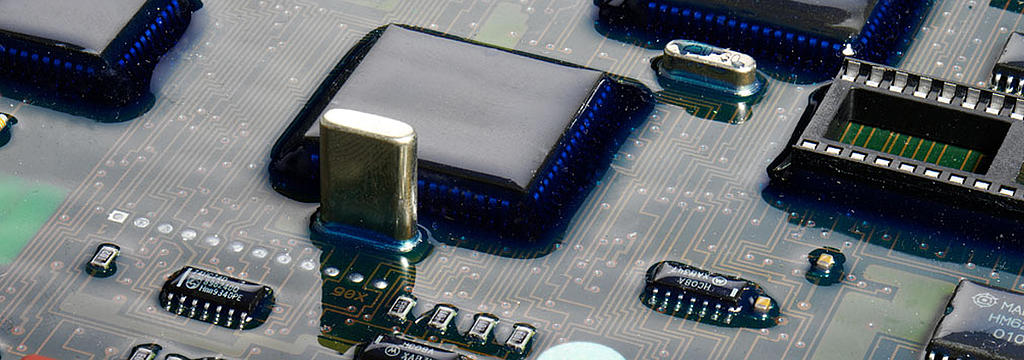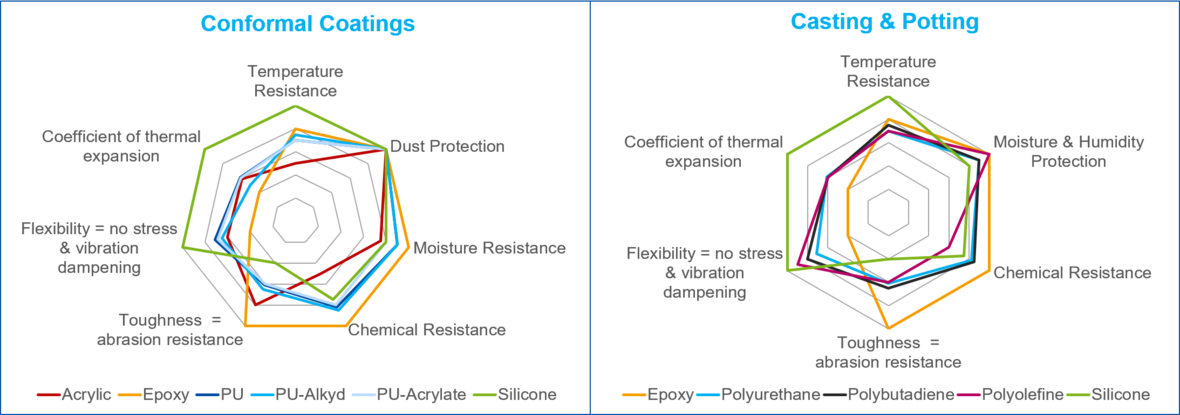When protecting electronic components, it is essential that suitable conformal coatings or casting and potting resins are chosen, to ensure that the whole module functions properly and for a long time. Depending on the application, a choice can be made between thin- and thick-film coatings or casting resins for full potting of electronics. In addition to preferred curing mechanisms and application options, the underlying chemistry of the chosen protective coating or potting resin is a decisive factor in the choice of material.
Some polymers meet the range of demands placed on the component better than others, and therefore the specific choice of the chemistry used is an important part of providing electronic protection. Figure 1 shows the properties of typical polymers for conformal coatings on the left and the properties of common casting and potting resins on the right.
Figure 1: Comparison of properties of typical polymers for conformal coatings (left) and casting and potting resins (right)
When the chemistry is chosen, a compromise must always be reached between the different material properties in each case. Polyurethanes and polybutadienes are generally very versatile and have a good combination of material hardness and flexibility, chemical resistance and a broad temperature range in which they can be used. But if the electronics must be protected from mechanical forces or very aggressive chemicals, epoxides are the first choice. The extreme hardness of the material can also lead to problems, however. Stresses resulting during temperature fluctuations, for example, are transmitted directly to the component and can even damage it in the worst case. For this reason, epoxides are often used only for very specific applications in the electronics field. By contrast, polyolefins are characterised by their flexibility, which results in their outstanding performance in temperature shock testing, and by their high degree of hydrophobicity, which provides excellent protection against moisture and makes polyolefins the obvious choice for protecting electronic components with direct water contact. For applications exposed to high operating temperatures and also requiring a high level of material flexibility over the entire temperature range, silicones are the gold standard. However, silicones have a higher permeability to water vapour and corrosive gases in comparison with other polymers. Table 1 shows selected materials from each product group, divided into conformal coatings and casting resins.
Table 1: Overview of selected products of different chemistries divided into conformal coatings and casting resins.
| Conformal Coatings | |||
| Chemistry | Product | Application | |
| Acrylic | Bectron® PL 1104 | Thin film coating, easy application, solvent based varnish, room temperature drying, flame retardant according to UL 94 V-0, inexpensive coating | |
| Epoxy | Bectron® PL 5622‑250 | Thin film coating, VOC-free, UV- and heat cure, flame retardant according to UL 94 V-0 | |
| Polyolefin | Bectron® MR 3404 | Thick film coating, melting resin, VOC-free, excellent dielectric properties, suitable for high frequency applications, no safety classification | |
| Polyurethane | Bectron® PK 4344 | Thick film coating, VOC-free, heat curing, no safety classification | |
| Polyurethane‑Acrylic | Bectron® PT 4600 | Thick film coating, VOC-free, UV and moisture curing, flame retardant according to UL 94 V-0 | |
| Polyurethane‑Alkyd | Bectron® PL 4122‑40E | Thin film coating, solvent based varnish, versatile application - combines hardness with sufficient flexibility as well as chemical and thermal resistance, flame retardant according to UL 94 V-0 | |
| Silicone | Bectron® SC 76V1-20 | Thick film coating, VOC-free, moisture curing, very soft and flexible coating, thermal resistance up to 200°C | |
| Casting & Potting | |||
| Polybutadiene | Bectron® PB 3252 | Two component potting material, very good adhesion, excellent mechanical properties | |
| Polyolefin | Bectron® MR 3406 FR | One component melting resin, VOC-free, excellent dielectric properties, suitable for high frequency applications, no safety classification, flame retardant according to UL 94 V-0 | |
| Polyurethane | Bectron® PU 4522 | Two component potting material, combines good mechanical properties and chemical resistance, flame retardant according to UL 94 V-0 | |
| Epoxy | Bectron® EP 5504 | Two component potting material, very high material hardness (83 Shore D), outstanding chemical resistance, good thermal conductivity, Thermal Class F (155°C), flame retardant according to UL 94 V-0 | |
| Silicone | Bectron® SK 75V2-45 | Two component potting material, soft and flexible potting, thermal resistance up to 200°C, flame retardant according to UL 94 V-0 | |
If you have any questions about material selection or specific applications, please do not hesitate to contact us directly at bectron.ELANTAS.europe@altana.com

